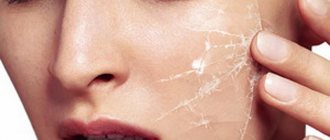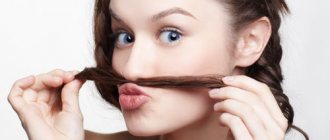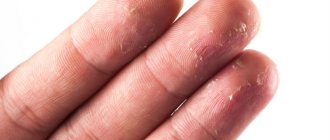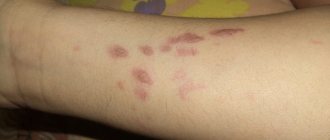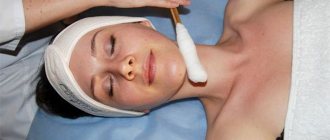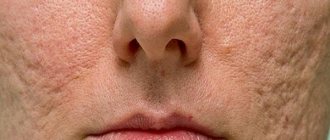Ichthyosis is a genetic disease in which the process of keratinization of the skin is disrupted. Hard scales, reminiscent of fish scales, form on it, and keratin with an altered structure accumulates in the epidermis. Most often, ichthyosis manifests itself in early childhood or even immediately after birth; less often, the disease is acquired.
Patients with this gene mutation suffer from impaired thermoregulation and their metabolism slows down. Due to the increased activity of enzymes in oxidative reactions in patients with ichthyosis, skin respiration processes are accelerated, the functioning of the thyroid gland, gonads and adrenal glands is disrupted. A person experiences a deficiency of cellular and humoral immunity. Dysfunction of the sweat glands is observed, which, against the background of improper absorption of vitamin A, leads to excessive keratinization of the skin. With ichthyosis, there is an excess of keratin with a disturbed structure. The shedding of dead skin cells occurs too slowly. Horny scales form on the skin, between which amino acid complexes accumulate, which contribute to hardening of the skin. Because of this, the formations are tightly linked to each other, and their separation is painful.
Patients with ichthyosis are characterized by brittle and dull hair, splitting nails, multiple caries, and patients often suffer from retinitis and conjunctivitis, and suffer from myopia.
Lamellar ichthyosis
Ichthyosis on the hands
Why does peeling begin?
Peeling usually occurs when an excess layer of dead epithelial cells or excessive growth of the stratum corneum forms on the surface of the skin. This symptom indicates a violation of the natural processes of keratinization and rejection. The plates formed in this case can have different shapes, thickness, area and density of attachment to the underlying layers.
Peeling most often occurs after damage to the superficial or deep layers of the dermis. In this case, aggressive chemicals, excessive insolation, unfavorable meteorological conditions, various microorganisms and antibodies to one’s own skin cells can act as the main etiological factor.
Peeling is also said to occur when flaking superficial crusts appear on the skin. Most often, they are formed after the drying of lymph and ichor, which are released from cracks or bursting blisters in some dermatological diseases.
The main causes of peeling skin:
- irrational use of degreasing cosmetics,
- the use of unsuitable skin type or low-quality creams, lotions and masks, which is especially critical during periods of hormonal changes in the body,
- abuse of local alcohol-based products, which often happens in a teenager who has acne and peeling skin on the face,
- an allergic reaction in response to the intake of an allergen from food or its direct contact with the skin,
- a period of active skin restoration after aggressive cosmetic procedures, peeling most often appears after facial cleansing and dermabrasion,
- neglect of protective equipment when working outdoors in unfavorable weather conditions, when tanning under the sun or in a solarium,
- frequent washing with alkalizing soap without subsequent moisturizing of the skin,
- hypovitaminosis A, E, B, lack of zinc, selenium and a number of other microelements,
- various dermatological diseases of infectious and non-infectious etiology.
In some cases, due to improper care and hypovitaminosis, peeling is maintained against the background of inadequate self-medication. After all, people suffering from dermatological problems usually ask what to put on their face, first from their friends and pharmacists. Using a variety of masks, creams and even corticosteroid ointment, they often worsen their condition. Therefore, treatment for peeling facial skin should be prescribed by a specialist after establishing the true cause of this problem.
Many women and men believe that if the surface of the face begins to peel off, it means that the body lacks some substances. This problem becomes especially relevant in the summer. This is due to the fact that the sun actively affects the skin, drying it out. Sometimes the skin becomes dehydrated due to the use of various cosmetics: foundations, powders, creams.
In addition, in an effort to improve their appearance, many use special mattifying lotions and tonics, which, up to a certain point, do an excellent job of drying out the skin in certain areas of the face. However, after some time, this product causes severe peeling, which can be extremely difficult to get rid of.
To avoid negative consequences, try not to use anti-acne products too often. These are mainly roll-on preparations, which sometimes even contain alcohol. It is separately noted that this drug will not remove inflammation. As a result of its effect on the surface of the face, the skin becomes very dry and begins to peel off. It is very difficult to get rid of these unpleasant symptoms, since the cover is severely damaged.
What to do?
It depends on the causes of peeling, because the disease can be either cosmetic in nature or be a symptom of serious internal disorders.
However, it is imperative to take steps to eliminate the defect: slight redness quickly turns into a drying spot, which actively peels off and grows, or its color becomes more intense and noticeable.
From a minor defect, the problem grows to universal proportions, spoils the mood and reduces self-esteem. And here it is almost impossible to cope without long-term treatment and the help of specialists.
Causes of peeling on the face
Every girl who has discovered peeling on her face, upon closer examination, will also notice the manifestations of tight areas of skin, depleted, dried out to such an extent that the skin is ready to peel off in whole pieces overnight. First of all, when identifying the reasons why the skin on your face is peeling, you should evaluate your lifestyle and what factors from it can influence this facial condition:
- This is possible if you have a very dry skin type,
- the disease manifested itself under climatic conditions: severe frost, freezing wind, skin exposed to prolonged exposure to ultraviolet radiation, a lot of salt from sea water from frequent bathing, very dry air due to air conditioning,
- manifestation of an allergy to something,
- peeling appeared after visiting a beauty salon or some procedures,
- your body is dehydrated or you drink little water,
- genetic characteristics: you inherited dry skin on your face and body,
- the presence of wounds, cracks, or any inflammation on the face,
- Treatment with medications or taking antibiotics can cause peeling of the skin.
To correctly identify the conditions that influenced the manifestation of the disease, evaluate each factor for the possibility of its involvement in this in your particular case. These are the main causes of peeling of the face and body skin. Without correct identification of the cause, it will not be possible to adequately carry out treatment. As the influencing factors are identified, we begin to apply treatment and recreational procedures, in the salon or at home.
Factors that provoke peeling of the facial skin can be divided into external and internal. Thus, eliminating the external source of irritation and maintaining a sufficient level of skin hydration will quickly get rid of peeling. While internal causes are often harbingers of more serious pathological processes developing in the body, which only a specialist can help identify.
So, external reasons include:
- harmful effects of the environment: changes in temperature, humidity, chapping, frostbite, exposure to ultraviolet and ionizing radiation on the skin,
- contact with allergens (contact dermatitis) through air, water, cosmetics and clothing,
- improper skin care: using cosmetics that are not suitable for your skin type or age limit,
- damage to the integrity of the epithelium (burn lesions, tissue scarring).
Internal causes of peeling skin, as a rule, are:
- lack/excess of certain vitamins or their groups, macro- and microelements (avitaminosis/hypovitaminosis),
- consuming food to which the body responds with an allergic reaction,
- taking certain medications,
- development of skin diseases (mycosis, dermatitis, psoriasis, ichthyosis, eczema, skin cancer),
- psychoneurological disorders,
- hormonal disorders,
- hereditary factor.
When to see a doctor
Typically, a person may experience mild itching after showering. In some cases, itching is not due to dry skin. Health conditions such as nerve damage and multiple sclerosis can cause overactive nerves in the skin. It may cause itching without a rash or other obvious cause.
Itching caused by a medical condition can lead to excessive scratching, which can irritate the skin and make the itching worse. It can also cause an infection. Sometimes a mental health condition can lead to skin scratching. Some mental illnesses that can cause this include:
- depression
- anxiety
- obsessive-compulsive disorder
- excoriation
If a person suspects that they have a nervous or mental illness, they should talk to their doctor.
Peeling as a sign of dermatological diseases
The appearance of flaking skin flakes can be a sign of many dermatological diseases. In this case, the use of cosmetics and procedures will not be enough; a complex effect with careful individual selection of drugs is required. Since it is impossible to get rid of peeling on the face without affecting the main links of pathogenesis, it is necessary to consult a doctor as early as possible for examination and establishment of an accurate diagnosis. And self-medication can contribute to the complicated course of the disease.
In dermatological diseases, peeling in most cases is a secondary symptom. It appears only after some time against the background of papules, vesicles or nodular changes and is a sign of the natural development of pathological foci. The nature of the resulting scales depends on the etiology of the disease and the presence of impurities of sebum, lymph or serous-purulent discharge.
Most of these diseases are acquired. Only ichthyoses are hereditary conditions, leading to characteristic damage to the entire skin even before the birth of the child. In atopic dermatitis, there is also a congenital predisposition associated with impaired functioning of the immune system.
Some diseases that lead to peeling
Psoriasis
It is a chronic non-infectious disease with a rather complex pathogenesis. It results in the appearance of red, itchy lesions on the skin that tend to spread and coalesce. Psoriatic lesions on the face are an uncommon occurrence; in this case, they speak of an atypical form of the disease. After all, the favorite places for psoriasis rashes are the extensor surfaces of the limbs and the torso.
Psoriasis rashes are predominantly localized around the eyes, eyebrows and nasolabial folds. But there is also a special form of the disease - seborrheic psoriasis. In this case, plaques form in places with increased formation of sebum, mainly at the border of the scalp, naso-buccal folds and behind-the-ear areas. This disease is differentiated primarily from seborrhea (seborrheic dermatitis).
Seborrhea
Associated with dysfunction of the sebaceous glands. In this case, pathological lesions can appear on the face, behind the ears and on the scalp. There is a dependence of the severity of the disease on hormonal status, which is why seborrhea is more often detected in men and adolescents. In women, its debut may be due to a decrease in estrogen levels with an increase in the concentration of androgen-like substances.
There are 2 forms of seborrhea: dry and oily. Irritation, dryness, itching and severe flaking are the main symptoms of dry seborrheic dermatitis. In this case, red-pink itchy lesions appear in the eyebrows and cheeks, they can also affect the eyelash growth area. The changes are symmetrical and often involve the scalp.
Systemic lupus erythematosus
SLE is a disease with an autoimmune mechanism affecting the skin of the face. The rashes that appear in this case are localized mainly in the nasobuccal areas, leading to the formation of a characteristic “butterfly”. Systemic lupus erythematosus is characterized by erythema, infiltration and follicular hyperkeratosis of the skin. After some time, they are replaced by cicatricial atrophy, which begins to form from the middle of the lesion.
Patients with a significant history of the disease have all possible types of skin changes on their face. In the center of a long-existing lupus lesion there is an area of smooth, smooth, thin, atrophic white skin. It is surrounded by an infiltration ridge, covered with dry, tight-fitting scales with spiny outgrowths on the underside. And on the periphery there is a rim of hyperemia with clear boundaries. Fresh lesions are red spots with a dry surface.
Perioral dermatitis
It is one of the most common diseases leading to peeling on the face. It is characterized by the appearance of erythematous scaly patches and a papulopustular rash around the mouth and chin. The red border of the lips is never involved in the pathological process; often there is even a narrow strip of unchanged skin along it.
Skin changes do not have clear boundaries, and the elements of the rash tend to group and gradually transform. Very often, with perioral dermatitis, patients voluntarily use corticosteroid cream for peeling facial skin. This tactic is wrong. After all, hormonal drugs themselves support this disease, although they help reduce the severity of the main symptoms.
Home remedies for flaking
Peels on the skin are an “SOS” signal from your body. It is necessary to identify and eliminate the causes of such a failure as quickly as possible. Both professional recommendations from specialists and skin care products will help you with this, many of which you can prepare at home.
Before using them, be sure to cleanse the skin of flaky particles. Soft scrubs are used for this. For example, an oatmeal scrub is made like this: oatmeal poured with boiling water is infused for 20 minutes, egg white is added to it. This mixture is applied to the face with gentle massaging movements. After 3 minutes of this massage, the mixture is washed off with water.
If honey does not cause you an allergy, try the following method: water is mixed with melted honey in equal proportions, after which the solution is applied to the face with massaging movements. After this, the face is rinsed with water and a moisturizer is applied.
You can also use pieces of apples, watermelon, coffee grounds or a piece of white bread soaked in water as a scrub. After the scrub, you need to apply a nourishing mask to your face.
Nutritious cream
A nourishing cream that can easily be prepared at home will help remove peeling facial skin. To do this, carefully grind 1 tablespoon of soft butter with 1 teaspoon of honey, and with 1 tablespoon of banana pulp (instead of banana, you can use the pulp of kiwi, persimmon, sweet ripe pear, or apricots). Apply the resulting composition to your face, lightly pressing it into the skin, and leave for 20-25 minutes, then wash with slightly warm water.
Carrot mask
Finely grate 1 small carrot. Add to it 1 tablespoon of honey, egg yolk and a teaspoon of aloe juice. Apply a thick layer and rinse with massage movements after 30 minutes.
Oatmeal mask
If the skin peels from time to time, then an oatmeal mask helps during such aggravated periods. Pour hot milk over a tablespoon of oatmeal until the milk completely covers the oatmeal and leave for 5 minutes. Then add a teaspoon of honey and the same amount of soft butter. Apply by massaging with finger pads, then leave for 15 minutes. Remove the mask with cotton swabs soaked in milk.
Glycerin based mask
Helps with frequently flaky skin (all components for this natural remedy can be purchased at any pharmacy): mix one teaspoon of glycerin with one tablespoon of grape seed oil (you can take apricot or peach), with the same amount of mineral or boiled water and 2- 3 drops of ammonia.
Curd mask
Mix two tablespoons of full-fat cottage cheese with one teaspoon of honey and a teaspoon of sour cream. Apply this nourishing mask to your face for 15-20 minutes,
Apple-honey mask
Ingredients: honey, 2 tablespoons, apple, 1 piece.
How to do it: remove the peel from the apple, cut out the core, chop the apple in a blender or grate it, add honey, mix, hold for 20 minutes, rinse the mixture from your face with warm water.
Olive-oat mask
To prepare this mask against peeling facial skin at home, you will need the simplest products available in every home, oatmeal, milk and honey, olive oil. The latter can be replaced with any other vegetable oil (sunflower, peach, almond).
Mix 1 tablespoon of warm oatmeal, pre-cooked in milk, with 1 teaspoon of warm honey and olive oil. Apply the mask in a thick layer to your face and leave for 20 minutes. Using massaging movements, remove any remaining mask and wash your face with warm water.
Remember that any peeling on the face is a signal from your body that there are certain malfunctions in it that need to be eliminated as quickly as possible. Modern cosmetology and medicine successfully cope with such skin problems if you recognize the causes of peeling in time and seek help from specialists.
Instead of output
The skin is a delicate and sensitive organ that signals us about problems. If you have neglected your health for a long time, then get ready for a long “payback” in the form of care and treatment.
Many people may be at risk for flaky skin due to predisposition, lack of proper care and cleansing, or illness. But dryness and flaking are not an eternal diagnosis; they can and should be dealt with. And believe me, the result is worth it!
Don't forget to like and rate the article!
Did you like the article? Subscribe to site updates via RSS, or follow on Twitter, VKontakte, Odnoklassniki, Facebook or Google Plus. And also receive new articles by E-Mail.
Cosmetic masks to help flaky skin
After we have gotten rid of dead skin particles with peeling, it is necessary to moisturize and “saturate” the skin with various beneficial substances. Nourishing masks are perfect for this. Of course, for these purposes you can use products purchased in specialized cosmetic stores or pharmacies.
As with using scrubs, before using a cosmetic face mask, you need to determine your skin type - dry, oily or combination.
Here are some recipes:
- Carrot-curd mask. Suitable for dry skin types. Ingredients – carrot juice, olive (or any other vegetable) oil, warm milk, cottage cheese (15-20% fat). Take all components in equal proportions and mix until a homogeneous paste is obtained. Apply the product to your face for 15 minutes, then rinse with warm water. It is also useful to wipe your skin with an ice cube afterwards.
2. Masks made from fermented milk products. You can take kefir, fermented baked milk, acidophilus or yogurt and apply it to cleansed facial skin. It is advisable to apply a fabric mask on top and leave the product on for 15-20 minutes. This remedy should be used before bedtime, as after it red spots may appear on the face, which go away a few hours after the procedure. Suitable for combination and normal skin.
